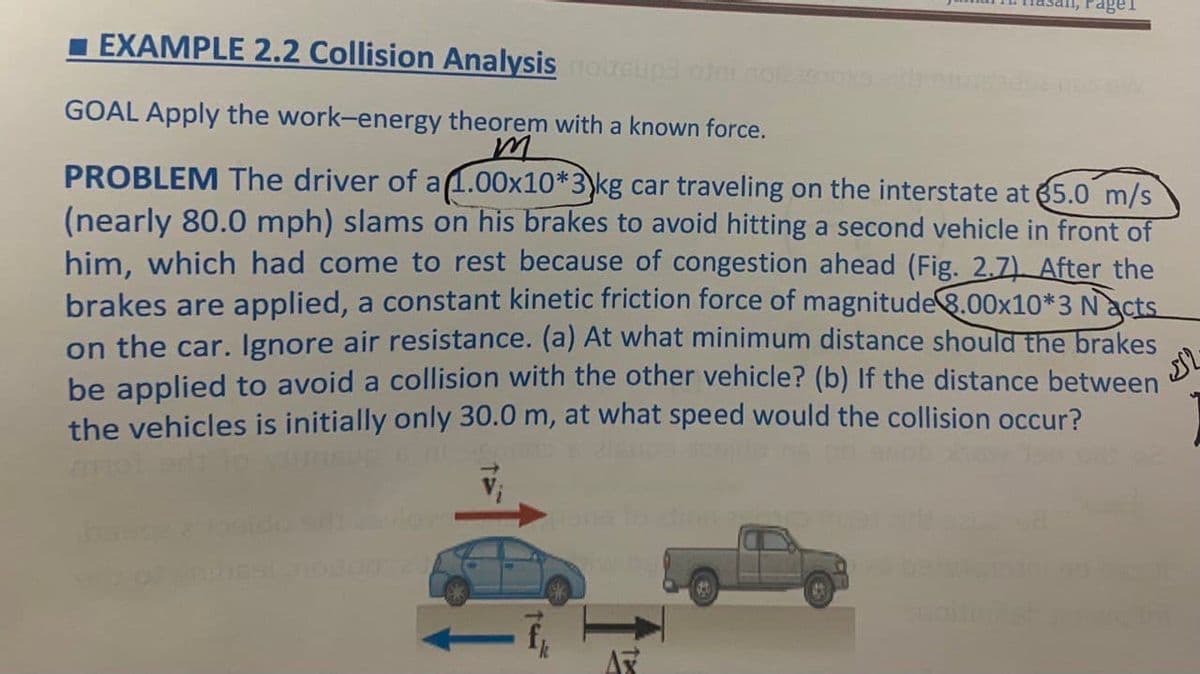PROBLEM The driver of a1.00x10*3)kg car traveling on the interstate at 65.0 m/s (nearly 80.0 mph) slams on his brakes to avoid hitting a second vehicle in front of him, which had come to rest because of congestion ahead (Fig. 2.7) After the brakes are applied, a constant kinetic friction force of magnitude8.00x10*3 N acts on the car. Ignore air resistance. (a) At what minimum distance should the brakes be applied to avoid a collision with the other vehicle? (b) If the distance between the vehicles is initially only 30.0 m, at what speed would the collision occur?
PROBLEM The driver of a1.00x10*3)kg car traveling on the interstate at 65.0 m/s (nearly 80.0 mph) slams on his brakes to avoid hitting a second vehicle in front of him, which had come to rest because of congestion ahead (Fig. 2.7) After the brakes are applied, a constant kinetic friction force of magnitude8.00x10*3 N acts on the car. Ignore air resistance. (a) At what minimum distance should the brakes be applied to avoid a collision with the other vehicle? (b) If the distance between the vehicles is initially only 30.0 m, at what speed would the collision occur?
Physics for Scientists and Engineers: Foundations and Connections
1st Edition
ISBN:9781133939146
Author:Katz, Debora M.
Publisher:Katz, Debora M.
Chapter9: Energy In Nonisolated Systems
Section: Chapter Questions
Problem 6PQ
Related questions
Topic Video
Question

Transcribed Image Text:1 EXAMPLE 2.2 Collision Analysis oeupd onno
GOAL Apply the work-energy theorem with a known force.
PROBLEM The driver of a1.00x10*3)kg car traveling on the interstate at 65.0 m/s
(nearly 80.0 mph) slams on his brakes to avoid hitting a second vehicle in front of
him, which had come to rest because of congestion ahead (Fig. 2.7) After the
brakes are applied, a constant kinetic friction force of magnitude8.00x10*3 N acts
on the car. Ignore air resistance. (a) At what minimum distance should the brakes
be applied to avoid a collision with the other vehicle? (b) If the distance between
the vehicles is initially only 30.0 m, at what speed would the collision occur?
Expert Solution
This question has been solved!
Explore an expertly crafted, step-by-step solution for a thorough understanding of key concepts.
This is a popular solution!
Trending now
This is a popular solution!
Step by step
Solved in 2 steps with 2 images

Knowledge Booster
Learn more about
Need a deep-dive on the concept behind this application? Look no further. Learn more about this topic, physics and related others by exploring similar questions and additional content below.Recommended textbooks for you

Physics for Scientists and Engineers: Foundations…
Physics
ISBN:
9781133939146
Author:
Katz, Debora M.
Publisher:
Cengage Learning


College Physics
Physics
ISBN:
9781938168000
Author:
Paul Peter Urone, Roger Hinrichs
Publisher:
OpenStax College

Physics for Scientists and Engineers: Foundations…
Physics
ISBN:
9781133939146
Author:
Katz, Debora M.
Publisher:
Cengage Learning


College Physics
Physics
ISBN:
9781938168000
Author:
Paul Peter Urone, Roger Hinrichs
Publisher:
OpenStax College

Glencoe Physics: Principles and Problems, Student…
Physics
ISBN:
9780078807213
Author:
Paul W. Zitzewitz
Publisher:
Glencoe/McGraw-Hill

College Physics
Physics
ISBN:
9781285737027
Author:
Raymond A. Serway, Chris Vuille
Publisher:
Cengage Learning

Physics for Scientists and Engineers, Technology …
Physics
ISBN:
9781305116399
Author:
Raymond A. Serway, John W. Jewett
Publisher:
Cengage Learning